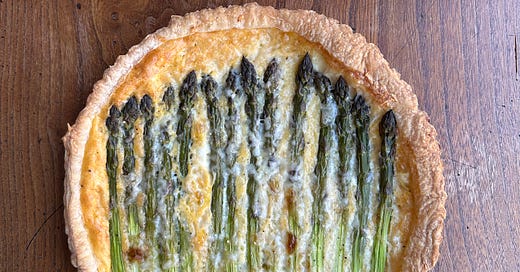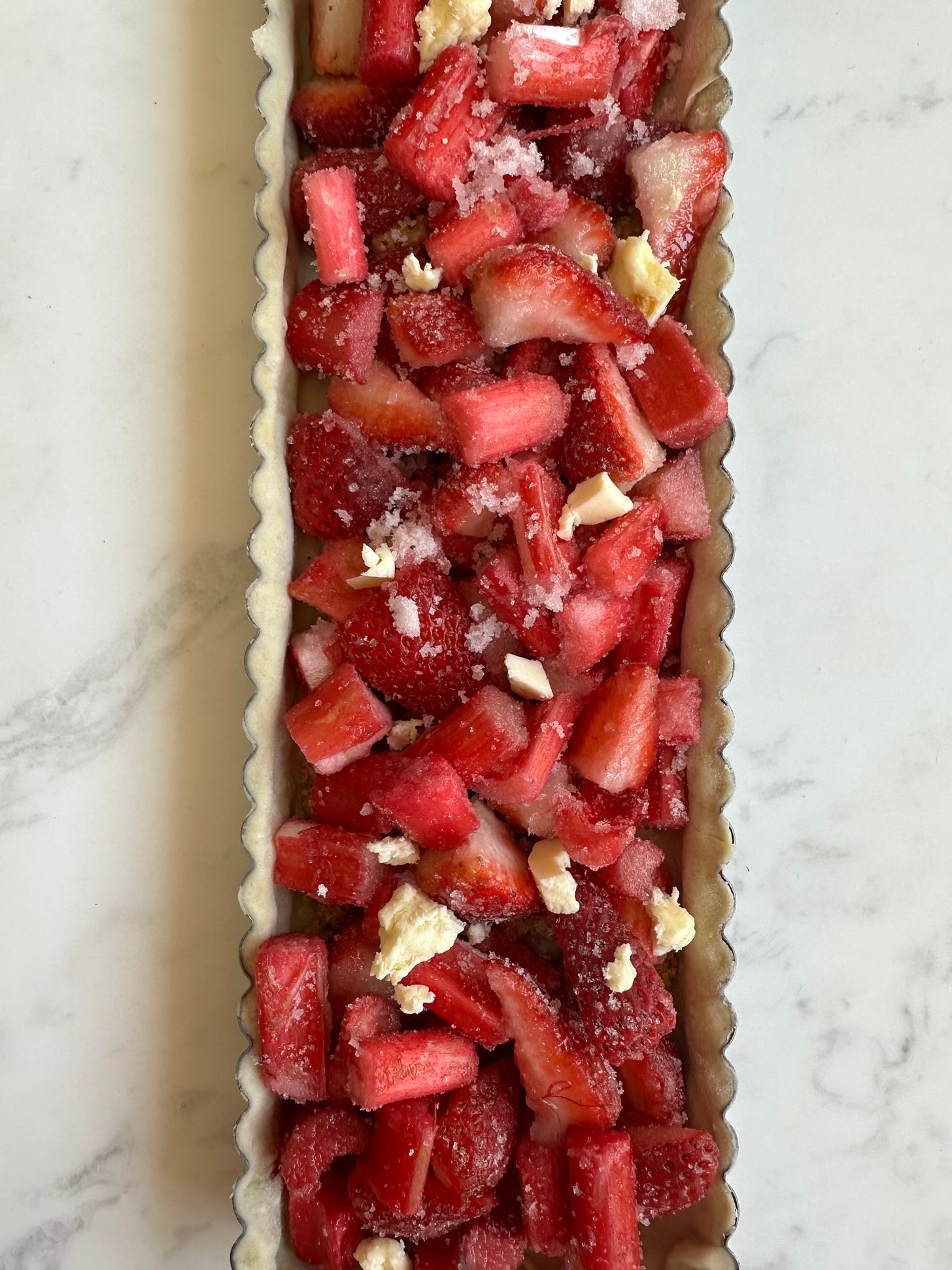The Queen of Tartes
How can you not love something that's open to whatever you want to lay on it?
I haven't been to Paris for seven or eight years, but lately, it’s a place that’s very much on my mind. A big part of that is people — wonderful food people like
and , Carrie Solomon and , some of whom I know, a little, and some who I just admire from afar. It’s fun to imagine popping into town and strolling to the market with Jane, or harvesting wild garlic with Carrie. Maybe I could sample Dorie’s new strawberry melba, or join David on an artisanal food field trip? My imagination lets me be bold and presumptuous, and thank god for that. Being able to dream is a huge part of being able to write. “What if…?” my mind asks, and off I go.But that’s not all, because Paris and I have history: When I was fourteen years old, an exceptionally devoted and cool French teacher took my class to visit the city of lights. It still makes me smile — the improbability of a group of middle-class kids from Edmonton, Canada, travelling to Paris in 1981. I had never even seen a croissant! Today, kids travel all over for all kinds of reasons, but at the time, at least where I came from, this was not normal. As a result, that trip and, particularly, the food experiences on that trip, imprinted me for a lifetime. Here’s a bit of how I felt that first morning, excerpted from my book, How to Share an Egg: A True Story of Hunger, Love and Plenty:
We arrived at the pension and went straight to breakfast, served in a type of basement, with stones piled up to form walls and a curved ceiling instead of the flat popcorn panels I was used to.
“Un café, s’il vous plaît?” I said to the aproned woman who raised her eyebrows at me.
“Café au lait?”
“Uh, oui.”
I’d just started drinking coffee at home, either black like my parents did or, if we were at the store, whitened with cream from the little triangular cartons that sat on the tables. What the waitress dropped off was entirely different: a smooth broth the color of butterscotch, foaming, warm, and served in a cereal bowl. Alongside the bowl of milky coffee sat a roll on a saucer, crescent shaped, flaky, and toasty brown. When I picked it up, I discovered it weighed almost nothing at all. Was it hollow? I broke the strange pastry apart, showering the tablecloth with crumbs, and dunked it into the bowl. Crisp and spongy, warm and cool, sweet, slightly bitter and even vaguely barnyard, my first café au lait–soaked croissant just about blew my mind.
I’ve been to Paris several times since 1981 — with Michael, with the kids. Once, we rented an apartment with an oversized blue door so we could shop, cook and sleep like locals. Another time, I let Michael take me, anxious and shaky, into an exhibit detailing French persecution of Jews during the war, and that became a key step in my journey to face my own family’s persecution in Poland during the Holocaust.
On one of these trips, we made a pilgrimage to E. Dehillier, a candy store-like nirvana for cooks who love their tools. It was almost twenty years ago, but I remember exactly what I bought: A citrus zester, a French rolling pin, three little knives with wooden handles and, almost as an after thought, two tart pans with removable bottoms.
It is not hyperbolic to say that the tart pans (still like new, here with that wonderful French rolling pin) changed my kitchen life. It’s not only their quality, which is excellent, nor their pleasing sizes and shapes (about 13 x 4 inches for the rectangular and just over 10 inches in diameter for the round), and it’s only partially because I bought them in Paris. (A Google search yields many good options, no matter where you live.) I simply hadn’t know the open secret about tarts — that they’re easier than pie and up for just about anything.
Your filling can be savory or sweet, precooked or raw. Maybe it’s sautéed leeks with thyme and comté, or kale cooked down with onion and shallot, or perfectly in-season asparagus with Gruyère and a couple of beaten eggs (recipe below). On the sweet side, I’ve made tarts of apples, plums, sweet and/or sour cherries, peaches, nectarines, apricots, blueberries, raspberries and rhubarb-strawberry with a barely-there hazelnut filling. (Blitz 2/3 cup toasted hazelnuts with 2 tbsp flour and 1 tbsp sugar, and scatter over the bottom of the tart, under the fruit.)
In terms of crust, I am always short on time, so I often use frozen puff pastry (all butter, and rolled thin) but on relaxed weekends, I love to make a freeform rustic galette with a butter dough that, honestly, takes only a bit longer.
I am pining for Paris, and more goodies from E. Dehillier. Part of me thinks it’s ridiculous to travel across the ocean to (re)visit a cookware shop, but another voice tells me there is nothing extravagant about searching for joy, wherever you might find it. Plus,
says she will chill the champagne.Asparagus Gruyère Tart
I’ve eaten this for breakfast, lunch and dinner. You can make it without the eggs if you prefer, but I like the way they give it a bit of substance, without being anywhere near as eggy as a quiche.
1 sheet all-butter puff pastry, defrosted but still cold
1/4 cup (approx) all-purpose flour, for rolling and dusting
1 1/2 cups shredded Gruyère cheese, divided
3 large eggs
1/4 cup milk
2 tsp Dijon mustard
1/2 tsp salt and freshly ground pepper, to taste
14 - 16 fresh asparagus, washed, tough ends snapped off and bottoms peeled if very woody
Preheat oven to 400 F. Unwrap defrosted pastry and set on a lightly floured surface. Roll out pastry, turning over to prevent sticking, until approximate 1/4 inch in thickness.
Transfer pastry to a 10- or 11-inch round, non-stick tart pan, fitting gently into the bottom and sides. Run rolling pin across top of pan to trim excess pastry, reserving for another use. (There are some good ideas for leftover puff pastry here.)
Prick pastry here and there with a fork and scatter with 1 cup of the grated cheese. In a small bowl, beat eggs with milk, Dijon mustard, salt and pepper. Pour egg mixture over cheese.
Lay prepared asparagus into egg and cheese mixture in any pattern you desire. Sprinkle with remaining cheese and bake for 35 - 40 minutes, or until melted and golden. Enjoy hot.








Mum! I make a lot of lie but never tried with aspergus! Sounds delicious! Thank you 😊
Bonny! What a beautiful surprise! I'd so very much love to stroll around the market with you, and goodness knows I hope that time comes soon. And the thoughts of topping that off with gougèrs with Dorie and a bit of champagne - what a day it would be!